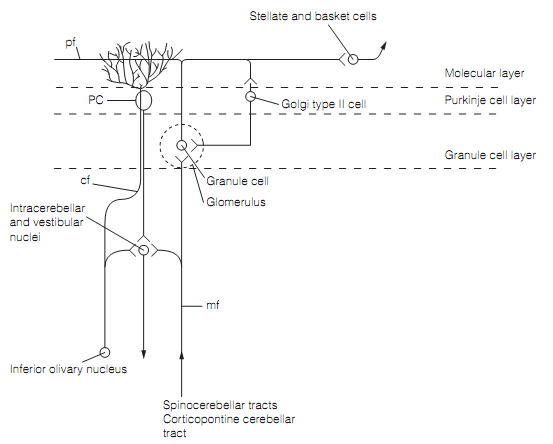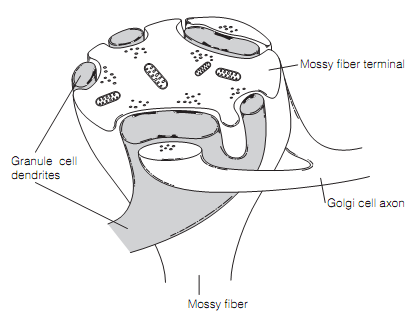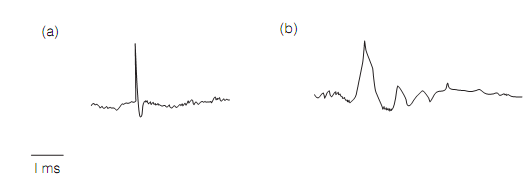Inputs to the cerebellar cortex
The cerebellar cortex has three layers and consists of five cell types which are organized into a simple circuit repeated millions of times as shown in figure below.

Figure: The basic circuitry of the cerebellar cortex. Mossy fibers (mf) and climbing fibers (cf) are excitatory, as are granule cells and intracerebellar nuclei cells. All other cell kinds are inhibitory. Stellate and basket cells inhibit adjoining Purkinje cells (PCs). Here, pf=parallel fiber.
The main input to the cerebellum is mossy fibers (mf), axons of second-order neurons from the spinal cord and brainstem passing on proprioceptor input, or the pontinecerebellar relay from the cerebral cortex conveying motor and sensory signals. Each mossy fiber terminates in a discrete patch of cortex. Mossy fibers are excitatory and glutamatergic, and after giving off an axon collateral that goes to the suitable deep cerebella nucleus, they synapse with granule cells in the synaptic complexes known as glomeruli which is as shown in figure. Each glomerulus consists of the swollen terminal of a single mossy fiber that forms 15–20 synapses with the surrounding dendrites of 4 to 5 granule cells. Mossy fibers branch, therefore each one can excite around 30 granule cells. Every granule cell is contacted by 5 to 8 mossy fibers. Glomeruli also consist of axodendritic synapses among Golgi cells as shown below and granule cells.

Figure: The structure of a cerebellar glomerulus. All synapses are axodendritic.
Granule cells in the granule cell layer are small (5–8 µm diameters) and one of the most frequent neurons kinds in the brain. Granule cell axons ascend to the most superficial layer of the cerebellar cortex, the molecular layer, wherever they bifurcate into parallel fibers which in primates expand for 6 mm or therefore in each direction along the long axis of a folium. The parallel fibers intersect with the perpendicularly oriented planar dendritic trees of Purkinje neurons. Since of this arrangement every parallel fiber excites a longitudinal beam of 2000–3000 Purkinje cells, making merely a single synapse with each one. Every Purkinje cell is contacted by around 200000 parallel fibers. Mossy fibers, and the granule cells determined by them, contain high background firing rates (50–100 Hz) which is changed by sensory input and during movements. The consequence of parallel fiber activity is to cause the Purkinje cell to fire simple spikes repetitively as shown in figure (a). Purkinje cells fire at background rates between 20 to 50 Hz and even weak mossy fiber input generates increased Purkinje cell firing. Furthermore, as Purkinje cells can fire in excess of 400 Hz they can follow a broad variety in firing of mossy fiber inputs.

Figure: Simple (a) and complex (b) spikes of Purkinje cells produced by mossy fiber or climbing fiber activation correspondingly.
The second input to the cerebellum is climbing fibers which come completely from the inferior olivary nucleus (ION) through the olivocerebellar tract. Each climbing fiber, of which there are around 15 million in humans, begins contact with around 10 Purkinje cells; each Purkinje cell acquiring input from merely one climbing fiber which winds its way round the soma and dendrites making around 300 powerful glutamatergic, excitatory synapses. The climbing fibers fire with a frequency of 1–10 Hz, each time causing the Purkinje cell to release a complex spike as shown in figure (b).A third diffuse set of inputs come from monoaminergic cells in the brainstem. They begin sparse connections with deep cerebellar nuclei and cortex to generate modulating effects.